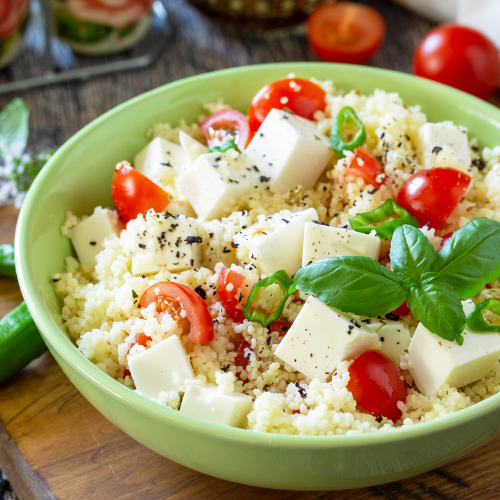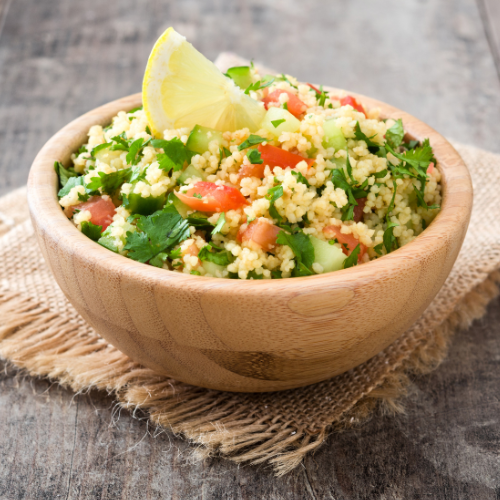Introduction.
The Mediterranean region, known for its rich culture, stunning landscapes, and, most importantly, its vibrant cuisine, offers a plethora of flavors that tantalize the taste buds. Among the many dishes that embody this culinary heritage, Mediterranean Couscous Salad stands out as a refreshing, versatile, and healthful option. This article will explore the origins of couscous, the ingredients that make up this delightful salad, the health benefits, various preparation methods, and how to customize the dish to suit your taste. Prepare to embark on a gastronomic adventure that will inspire you to bring a taste of the Mediterranean into your own kitchen.
The Origins of Couscous.
1.1 Historical Background
Couscous is a staple food in North Africa, particularly in countries like Morocco, Algeria, and Tunisia. Its origins date back to the 9th century, where it was likely first prepared by Berber communities. This ancient grain dish has since evolved, crossing cultural borders and becoming a beloved ingredient in Mediterranean cuisine.
1.2 Cultural Significance
In many Mediterranean cultures, couscous is more than just food; it’s a symbol of hospitality and tradition. Families often gather around a large bowl of couscous, sharing stories and laughter, making it a dish that fosters connection and community.
Ingredients for Mediterranean Couscous Salad.
2.1 The Base: Couscous
Couscous is made from semolina wheat, which is steamed and then dried. It has a unique texture that can absorb flavors beautifully, making it the perfect base for a salad.
2.2 Fresh Vegetables
A Mediterranean Couscous Salad typically includes a variety of fresh vegetables. Common choices include:
- Cucumbers: Crisp and refreshing, they add a cool crunch.
- Tomatoes: Sweet and juicy, they provide a burst of flavor.
- Red Onion: Offers a sharp bite that complements the other ingredients.
- Bell Peppers: Colorful and sweet, they add vibrancy to the dish.
- Parsley and Mint: Fresh herbs that elevate the salad with their aromatic qualities.
2.3 Proteins
To make the salad more filling, consider adding protein sources such as:
- Chickpeas: A classic addition that brings texture and heartiness.
- Feta Cheese: Adds a salty, creamy element (optional for vegans).
- Grilled Chicken or Shrimp: For meat lovers, these can enhance the dish’s flavor profile.
2.4 Dressings and Seasonings
The dressing is crucial in tying all the flavors together. A simple yet flavorful dressing can be made using:
- Olive Oil: A staple in Mediterranean cuisine, it adds richness.
- Lemon Juice: Bright and zesty, it balances the flavors.
- Salt and Pepper: Essential for seasoning.
Other optional ingredients for added depth include:
- Garlic: Fresh minced garlic can enhance the dressing’s flavor.
- Cumin or Paprika: Adds warmth and a hint of spice.

Health Benefits of Mediterranean Couscous Salad.
3.1 Nutritional Value
Mediterranean Couscous Salad is not only delicious but also packed with nutrients. The ingredients provide a good balance of carbohydrates, fiber, protein, and healthy fats.
- Couscous offers complex carbohydrates that provide energy.
- Vegetables contribute vitamins, minerals, and antioxidants that support overall health.
- Chickpeas add protein and fiber, helping to keep you feeling full and satisfied.
- Olive oil is rich in monounsaturated fats, known for their heart health benefits.
3.2 Weight Management
Due to its high fiber content and low calorie ingredients, Mediterranean Couscous Salad can be an excellent option for those looking to maintain or lose weight. The combination of protein and fiber helps curb hunger, making it easier to manage portion sizes.
3.3 Heart Health
The Mediterranean diet is renowned for its heart health benefits. Consuming foods rich in healthy fats, such as olive oil, along with a variety of fruits, vegetables, and whole grains, has been linked to lower risks of heart disease.
Preparing Mediterranean Couscous Salad.
4.1 Cooking Couscous
Cooking couscous is incredibly straightforward. Here’s a simple method:
- Measure the desired amount of couscous (about 1 cup serves 4).
- Boil 1.5 cups of water or vegetable broth in a pot.
- Stir in the couscous, cover the pot, and remove it from the heat.
- Let it sit for about 5 minutes until the couscous absorbs the liquid.
- Fluff it with a fork to separate the grains.
4.2 Chopping Vegetables
While the couscous is cooking, take the time to chop your vegetables. Aim for uniform sizes to ensure even distribution in the salad.
4.3 Making the Dressing
In a small bowl, whisk together olive oil, lemon juice, minced garlic, salt, and pepper. Adjust the seasoning according to your taste.
4.4 Assembling the Salad
Once the couscous has cooled, combine it with the chopped vegetables, protein (if using), and dressing. Toss gently to combine, and let it sit for at least 15 minutes to allow the flavors to meld.
4.5 Serving Suggestions
Mediterranean Couscous Salad can be enjoyed in numerous ways:
- As a Side Dish: Pair it with grilled meats or fish.
- As a Main Course: Add more protein and serve it as a complete meal.
- As a Picnic Option: Pack it in a container for a refreshing outdoor meal.
Customizing Your Salad.
5.1 Seasonal Ingredients
One of the great advantages of Mediterranean Couscous Salad is its adaptability. You can easily swap out ingredients based on what’s in season. For example, in the summer, consider adding:
- Zucchini: Grilled or raw, it adds a lovely texture.
- Radishes: For a peppery crunch.
- Cherry Tomatoes: Sweet and bursting with flavor.
5.2 Dietary Preferences
This salad can be easily tailored to meet various dietary needs. For example:
- Vegan: Omit feta cheese and ensure the dressing is dairy free.
- Gluten Free: Substitute couscous with quinoa or rice.
- Low Carb: Use cauliflower rice instead of couscous.
5.3 Flavor Profiles
Experiment with spices and herbs to create different flavor profiles. For instance:
- Mediterranean Twist: Add olives and sun dried tomatoes for a briny flavor.
- Middle Eastern Flair: Incorporate sumac and pomegranate seeds for a unique taste.
- Italian Inspiration: Mix in basil and balsamic vinegar for a fresh Italian twist.
Pairing Suggestions.
6.1 Beverages
When enjoying Mediterranean Couscous Salad, consider pairing it with beverages that complement the flavors:
- White Wine: A crisp Sauvignon Blanc or a refreshing Pinot Grigio pairs beautifully.
- Herbal Tea: Mint or chamomile tea can enhance the meal experience.
- Sparkling Water: A refreshing option to cleanse the palate.
6.2 Side Dishes
Enhance your meal by serving the salad alongside:
- Pita Bread: Perfect for scooping up the salad.
- Hummus: A creamy dip that pairs well with the salad’s flavors.
- Grilled Vegetables: Adds depth and complements the couscous.
Storing Leftovers.
If you have leftovers, storing them properly will ensure they last longer:
- Refrigerate: Store the salad in an airtight container in the fridge for up to 3 days.
- Freezing: While couscous can be frozen, it’s best to leave out fresh vegetables. Instead, freeze just the couscous mixture and add fresh ingredients when ready to serve.
Conclusion.
Mediterranean Couscous Salad is a delightful dish that brings the tastes of the Mediterranean right to your table. Its versatility, nutritional benefits, and vibrant flavors make it an ideal choice for any occasion, whether it’s a casual lunch, a picnic, or a holiday gathering. By experimenting with different ingredients and flavors, you can make this salad your own and enjoy a taste of the Mediterranean anytime.
Questions and Answers.
Q1: Can I prepare the Mediterranean Couscous Salad in advance?
A1: Yes, you can prepare the salad a day in advance. Just keep the dressing separate until you’re ready to serve to maintain the freshness of the vegetables.
Q2: Is couscous gluten free?
A2: No, traditional couscous is made from wheat and is not gluten free. However, you can use gluten-free alternatives like quinoa or rice.
Q3: How can I enhance the flavor of the salad?
A3: To enhance the flavor, consider adding roasted nuts, seeds, or spices such as cumin or smoked paprika for an extra layer of taste.
Q4: What are some good protein options to add to the salad?
A4: Good protein options include chickpeas, grilled chicken, shrimp, or even edamame for a unique twist.
Q5: Can I use dried herbs instead of fresh ones?
A5: Yes, you can use dried herbs, but the flavors may be less vibrant. Use about one third of the amount of dried herbs compared to fresh ones, as dried herbs

